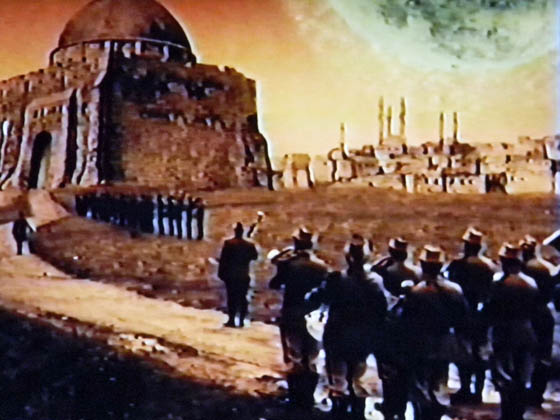 Karel Zeman (1910-1989) was a Czechoslovakian animator and filmmaker whose shorts and feature length films are like multi-media playgrounds in which actors move amongst baroque painted backdrops, interact with stop-motion animated creatures matted against deliberately flat, Victorian-style paintings and cut-outs, and seem to exist in several different planes of reality at once. Imagine an old, musty storybook springing to life and crawling off your lap. I encountered the world of Zeman as a child by stumbling right into the deep end: Na Komete (On the Comet, or Off on the Comet), his 1970 film in which Zeman continues to hone the handmade techniques developed in his earlier films like The Fabulous World of Jules Verne (1958), Baron Prásil (aka The Fabulous Baron Munchausen, 1962), and The Jester’s Tale (1964). On the Comet sat on the shelf at the video store in the Science Fiction section, with an undistinguished cover, and I rented it only when I’d already rented everything else in that section which wasn’t rated R. What I got melted my little mind; I was alternately baffled, excited, bored, and baffled again.
Karel Zeman (1910-1989) was a Czechoslovakian animator and filmmaker whose shorts and feature length films are like multi-media playgrounds in which actors move amongst baroque painted backdrops, interact with stop-motion animated creatures matted against deliberately flat, Victorian-style paintings and cut-outs, and seem to exist in several different planes of reality at once. Imagine an old, musty storybook springing to life and crawling off your lap. I encountered the world of Zeman as a child by stumbling right into the deep end: Na Komete (On the Comet, or Off on the Comet), his 1970 film in which Zeman continues to hone the handmade techniques developed in his earlier films like The Fabulous World of Jules Verne (1958), Baron Prásil (aka The Fabulous Baron Munchausen, 1962), and The Jester’s Tale (1964). On the Comet sat on the shelf at the video store in the Science Fiction section, with an undistinguished cover, and I rented it only when I’d already rented everything else in that section which wasn’t rated R. What I got melted my little mind; I was alternately baffled, excited, bored, and baffled again.
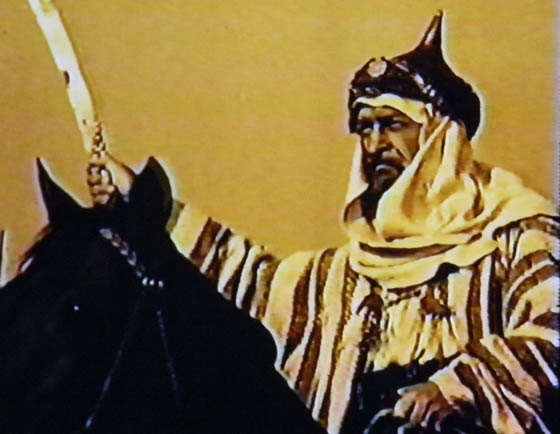 What I was actually watching was a badly dubbed and cropped presentation of a Czech fantasy film based on a two-part Jules Verne novel (1877’s Hector Servadac, which consists of To the Sun? and Off on a Comet!), being among the most obscure of his Les Voyages Extraordinaires science-fiction books. Though I quickly moved on as soon as the film ended, I never quite forgot that there was this very, very strange film – something with “comet” in the title – and as the years passed I began to wonder if I’d only dreamed it. (There are still several films I watched as a child which I’m trying to locate. If anyone knows of a TV-movie about a sorcerer’s apprentice which uses the America song “You Can Do Magic,” please let me know. Or maybe that one really was a dream.) So to prepare for tonight’s midnight movie, I tackled my childhood memory head-on. First I ordered a copy of the VHS tape – same tacky cover – off Amazon Marketplace, along with a 1960 edition of the Verne novel upon which it’s based. I endured all 460 pages of Hector Servadac, and was reminded of why I’ve always preferred H.G. Wells. When complaining to my father-in-law of the book’s rancid, and nonstop, anti-semitism, along with insufferable lectures on 19th-century astrophysics (a professor gives a speech which lasts for about 50 pages – even after one of Verne’s characters falls asleep!), he suggested that perhaps I didn’t need to read this book; after all, wasn’t it evident by now that the film couldn’t possibly be a faithful adaptation? Yes, true, but as a former English major, I have a dogged commitment to finishing books I start; and anyway, I wanted all the help I could get to shed light on this particularly blurry childhood memory. I wanted the context and background for On the Comet. In retrospect, I should have been watching other Karel Zeman films instead, but live and learn.
What I was actually watching was a badly dubbed and cropped presentation of a Czech fantasy film based on a two-part Jules Verne novel (1877’s Hector Servadac, which consists of To the Sun? and Off on a Comet!), being among the most obscure of his Les Voyages Extraordinaires science-fiction books. Though I quickly moved on as soon as the film ended, I never quite forgot that there was this very, very strange film – something with “comet” in the title – and as the years passed I began to wonder if I’d only dreamed it. (There are still several films I watched as a child which I’m trying to locate. If anyone knows of a TV-movie about a sorcerer’s apprentice which uses the America song “You Can Do Magic,” please let me know. Or maybe that one really was a dream.) So to prepare for tonight’s midnight movie, I tackled my childhood memory head-on. First I ordered a copy of the VHS tape – same tacky cover – off Amazon Marketplace, along with a 1960 edition of the Verne novel upon which it’s based. I endured all 460 pages of Hector Servadac, and was reminded of why I’ve always preferred H.G. Wells. When complaining to my father-in-law of the book’s rancid, and nonstop, anti-semitism, along with insufferable lectures on 19th-century astrophysics (a professor gives a speech which lasts for about 50 pages – even after one of Verne’s characters falls asleep!), he suggested that perhaps I didn’t need to read this book; after all, wasn’t it evident by now that the film couldn’t possibly be a faithful adaptation? Yes, true, but as a former English major, I have a dogged commitment to finishing books I start; and anyway, I wanted all the help I could get to shed light on this particularly blurry childhood memory. I wanted the context and background for On the Comet. In retrospect, I should have been watching other Karel Zeman films instead, but live and learn.
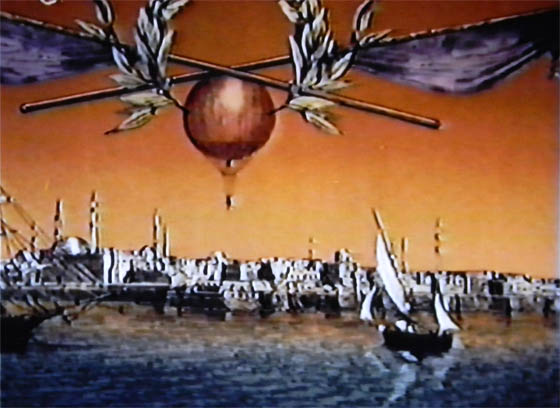 So, no – I can say now – On the Comet doesn’t have much to do with Jules Verne. Like most Verne adaptations, Zeman takes the premise and fills in plenty of colorful and fantastic details, along with some political satire. What grabbed me straight away was the look of the film. Although it begins with a color sequence – an old man introduces the story, which is essentially a flashback to his youth – the majority of the film is tinted black-and-white footage, most of it glowing a golden color to represent the desert heat of Algeria, but shifting, at times, to blue, red, or other shades to complement the scene. The opening credits use Victorian postcards, establishing Zeman’s principal motif. The first scene in the film is a moving diorama: a soldier is suspended in a balloon over a two-dimensional painting of a North African city; the live-action fellow is matted into the image which includes animated seagulls flying past him. It looks like one of the opening-credit postcards. Then he accidentally drops his lit cigar, setting fire to the city below; an Algerian child weeps while his city burns. Welcome to On the Comet. This is not an ordinary fantasy film.
So, no – I can say now – On the Comet doesn’t have much to do with Jules Verne. Like most Verne adaptations, Zeman takes the premise and fills in plenty of colorful and fantastic details, along with some political satire. What grabbed me straight away was the look of the film. Although it begins with a color sequence – an old man introduces the story, which is essentially a flashback to his youth – the majority of the film is tinted black-and-white footage, most of it glowing a golden color to represent the desert heat of Algeria, but shifting, at times, to blue, red, or other shades to complement the scene. The opening credits use Victorian postcards, establishing Zeman’s principal motif. The first scene in the film is a moving diorama: a soldier is suspended in a balloon over a two-dimensional painting of a North African city; the live-action fellow is matted into the image which includes animated seagulls flying past him. It looks like one of the opening-credit postcards. Then he accidentally drops his lit cigar, setting fire to the city below; an Algerian child weeps while his city burns. Welcome to On the Comet. This is not an ordinary fantasy film.
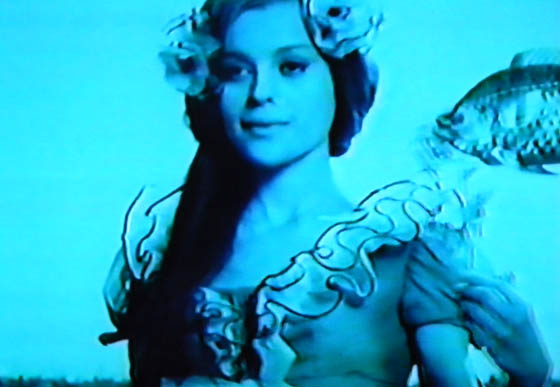 The hero is Lieutenant Servadac (Emil Horvath), and although his faithful, comic-relief companion Ben Zouf (Karel Effa) is present, Zeman changes Verne’s novel into a love story, introducing a beautiful young woman (Magda Vásáryová) for whom Servadac develops a fascination after he sees her image on a postcard in an Algerian market. While working a land survey with Ben, he stumbles off the edge of a cliff, landing in the sea. In a fabulous, blue-tinted sequence, we see bubbles float about Servadac’s head, glowing, undulating jellyfish, and the woman herself, like a mermaid of the deeps, holding a rose that an animated cut-out of a fish snatches out of her hand and carries away. When Servadac comes out of this reverie, he’s lying on a beach with the woman, named Angelika, leaning over him. She explains that she’s just escaped from a ship commanded by a corrupt Sheik, who’s plotting with the Spanish to spark a revolution in French Algiers. But overhead, a giant heavenly body appears in the sky like a rising moon, throwing lightning bolts and glowing green. Servadac and Angelika run from the comet, back into the walls of Algiers, where the French commander sits in a devastated, war-fraught city. His headquarters is the towering mosque, and there’s some comic business involving dust from the hole in the dome constantly falling upon his desk. (Double-feature idea: this, and Pontecorvo’s raw 1966 docudrama The Battle of Algiers. Just throwing that out there.)
The hero is Lieutenant Servadac (Emil Horvath), and although his faithful, comic-relief companion Ben Zouf (Karel Effa) is present, Zeman changes Verne’s novel into a love story, introducing a beautiful young woman (Magda Vásáryová) for whom Servadac develops a fascination after he sees her image on a postcard in an Algerian market. While working a land survey with Ben, he stumbles off the edge of a cliff, landing in the sea. In a fabulous, blue-tinted sequence, we see bubbles float about Servadac’s head, glowing, undulating jellyfish, and the woman herself, like a mermaid of the deeps, holding a rose that an animated cut-out of a fish snatches out of her hand and carries away. When Servadac comes out of this reverie, he’s lying on a beach with the woman, named Angelika, leaning over him. She explains that she’s just escaped from a ship commanded by a corrupt Sheik, who’s plotting with the Spanish to spark a revolution in French Algiers. But overhead, a giant heavenly body appears in the sky like a rising moon, throwing lightning bolts and glowing green. Servadac and Angelika run from the comet, back into the walls of Algiers, where the French commander sits in a devastated, war-fraught city. His headquarters is the towering mosque, and there’s some comic business involving dust from the hole in the dome constantly falling upon his desk. (Double-feature idea: this, and Pontecorvo’s raw 1966 docudrama The Battle of Algiers. Just throwing that out there.)
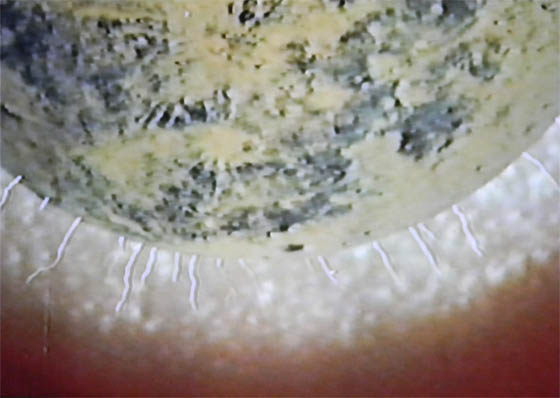 The comet hits the Earth just when the Sheik’s army sets off a bomb near the French troops and ride out against the city walls. The novel portrays this catastrophic event vaguely: a mist envelops the Earth, there’s a great earthquake, and pretty soon a section of North Africa and the Mediterranean are riding the comet away through the solar system. Zeman illustrates the impact by animating his characters flying through the air (a military band continues to play their instruments while airborne), and buildings splitting into jigsaw pieces and sailing vertically. Then everything falls back into place, including the buildings, which reassemble as the animation is reversed. Servadac immediately determines that they’re riding a comet, as he identifies the Earth disappearing into the sky (in the novel, it takes about 200 pages to draw this conclusion, but this film is only 74 minutes long, so Zeman gets efficient). From the besieged city, strange events are observed. A mutated giant fly is swatted over the commander’s desk. Beyond the walls, dinosaurs join the siege. Servadac rides out and frightens the dinosaurs off by dragging a wagon of clanging pots and pans. This technique so impresses the commander that he orders all the cannons thrown over the walls, and replaced by poles bearing strung-up kitchenware to rattle at invaders.
The comet hits the Earth just when the Sheik’s army sets off a bomb near the French troops and ride out against the city walls. The novel portrays this catastrophic event vaguely: a mist envelops the Earth, there’s a great earthquake, and pretty soon a section of North Africa and the Mediterranean are riding the comet away through the solar system. Zeman illustrates the impact by animating his characters flying through the air (a military band continues to play their instruments while airborne), and buildings splitting into jigsaw pieces and sailing vertically. Then everything falls back into place, including the buildings, which reassemble as the animation is reversed. Servadac immediately determines that they’re riding a comet, as he identifies the Earth disappearing into the sky (in the novel, it takes about 200 pages to draw this conclusion, but this film is only 74 minutes long, so Zeman gets efficient). From the besieged city, strange events are observed. A mutated giant fly is swatted over the commander’s desk. Beyond the walls, dinosaurs join the siege. Servadac rides out and frightens the dinosaurs off by dragging a wagon of clanging pots and pans. This technique so impresses the commander that he orders all the cannons thrown over the walls, and replaced by poles bearing strung-up kitchenware to rattle at invaders.
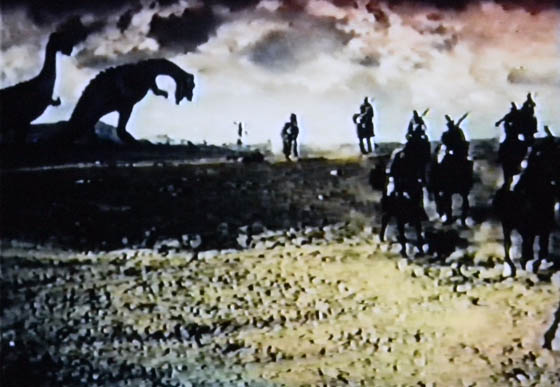 The dinosaurs are, by turns, traditionally animated, stop-motion animated, and manipulated puppets. Later in the film, Servadac leads a voyage on a steamship across the sea, and discovers a “lost world” crawling with dinosaurs. They even witness evolution first-hand, enacted at an accelerated pace: a fish with legs struts along the ground, and then grows the head of a wild boar, which prompts Ben Zouf’s suggestion that they go hunting. Verne has no dinosaurs in his book (just a volcano), but Zeman seems to enjoy pushing his Victorian-style fantasies into the realm of semi-psychedelic surrealism. Time and again On the Comet resembles the work of Terry Gilliam, who, at the time, was creating similar work in his stream-of-consciousness, Victorian cut-out animations for Monty Python’s Flying Circus. (His 1988 film The Adventures of Baron Munchausen also features a besieged city as its dominant setpiece.) The style in which Zeman presents his dinosaurs calls back as far as Willis O’Brien’s work on The Lost World (1925), but even more so the seminal animated film from Winsor McCay, “Gertie the Dinosaur” (1914). And his painted, two-dimensional sets deliberately evoke the work of Georges Méliès in “La voyage dans la lune” (1902) and his many other shorts.
The dinosaurs are, by turns, traditionally animated, stop-motion animated, and manipulated puppets. Later in the film, Servadac leads a voyage on a steamship across the sea, and discovers a “lost world” crawling with dinosaurs. They even witness evolution first-hand, enacted at an accelerated pace: a fish with legs struts along the ground, and then grows the head of a wild boar, which prompts Ben Zouf’s suggestion that they go hunting. Verne has no dinosaurs in his book (just a volcano), but Zeman seems to enjoy pushing his Victorian-style fantasies into the realm of semi-psychedelic surrealism. Time and again On the Comet resembles the work of Terry Gilliam, who, at the time, was creating similar work in his stream-of-consciousness, Victorian cut-out animations for Monty Python’s Flying Circus. (His 1988 film The Adventures of Baron Munchausen also features a besieged city as its dominant setpiece.) The style in which Zeman presents his dinosaurs calls back as far as Willis O’Brien’s work on The Lost World (1925), but even more so the seminal animated film from Winsor McCay, “Gertie the Dinosaur” (1914). And his painted, two-dimensional sets deliberately evoke the work of Georges Méliès in “La voyage dans la lune” (1902) and his many other shorts.
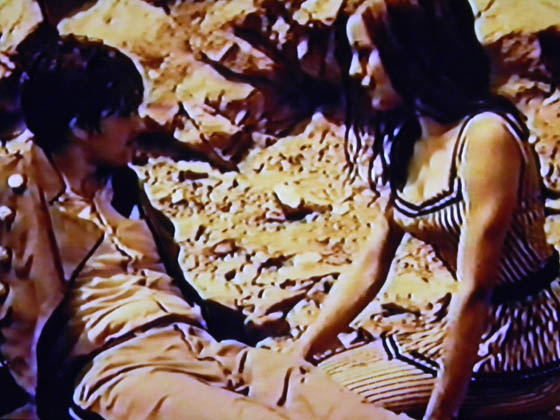 A close encounter with Mars convinces the inhabitants of the comet that doomsday is imminent, and so the battle is cancelled. When Mars passes safely by, the Sheik immediately resumes the assault. This plot, of Zeman’s invention, makes it clear that On the Comet is a satire; unlike Verne’s cast, the French, Algerian, and Spanish characters assembled for the film couldn’t care less that they are accidental explorers of the solar system. Their gaze is seldom fixed toward the sky. Thankfully, the film is not overlong, as the melodramatics of the plot are often tedious. Angelika and Servadac fall in love, and get married (after she fights off some jealous harem girls); the Sheik is always plotting; the French commander reacts with bullheaded stupidity, and so on. What’s most intriguing is a semi-lyrical conclusion which implies that it was all Servadac’s dream inspired by the postcard image of Angelika. This might be the most proper way to conclude a film like On the Comet, which piles on surrealism and absurdity. I can say now that I have seen this as an adult, and it still somehow cannot be captured. Appropriate, I guess, that I didn’t have the TV tuner in my computer to directly capture images from the VHS tape. I had to settle for snapping pictures with a camera of the television, like chasing Bigfoot. I can now replace my old and faded childhood memories, but On the Comet remains stubbornly elusive.
A close encounter with Mars convinces the inhabitants of the comet that doomsday is imminent, and so the battle is cancelled. When Mars passes safely by, the Sheik immediately resumes the assault. This plot, of Zeman’s invention, makes it clear that On the Comet is a satire; unlike Verne’s cast, the French, Algerian, and Spanish characters assembled for the film couldn’t care less that they are accidental explorers of the solar system. Their gaze is seldom fixed toward the sky. Thankfully, the film is not overlong, as the melodramatics of the plot are often tedious. Angelika and Servadac fall in love, and get married (after she fights off some jealous harem girls); the Sheik is always plotting; the French commander reacts with bullheaded stupidity, and so on. What’s most intriguing is a semi-lyrical conclusion which implies that it was all Servadac’s dream inspired by the postcard image of Angelika. This might be the most proper way to conclude a film like On the Comet, which piles on surrealism and absurdity. I can say now that I have seen this as an adult, and it still somehow cannot be captured. Appropriate, I guess, that I didn’t have the TV tuner in my computer to directly capture images from the VHS tape. I had to settle for snapping pictures with a camera of the television, like chasing Bigfoot. I can now replace my old and faded childhood memories, but On the Comet remains stubbornly elusive.
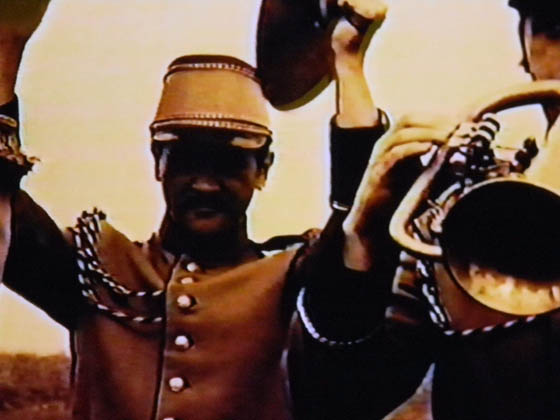
Apparently a DVD, in Czech with English subtitles, will be released on October 3rd. In the meantime, it’s still pretty difficult to see Karel Zeman’s work in this country, but there are lots of clips from his films on YouTube. I doubt I’m done with him, and will check back with more in the future.









